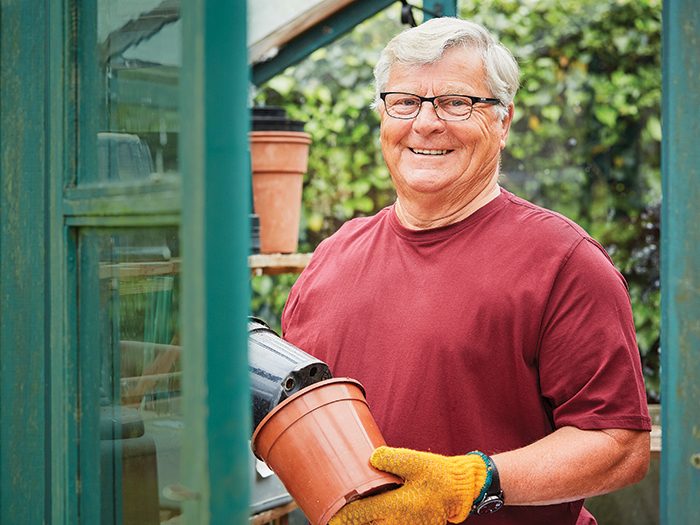How Doctors Are Mending Broken Hearts
Rapid and more effective treatments at specialist cardiology centers are curbing Europe’s No. 1 killer

Rod Gamble’s father died of a heart attack at 59, and there were signs that Rod too might not live to see old age when he developed life-threatening cardiac rhythm problems in his early sixties. But thanks to ever-improving heart treatments, the retired parcel distribution company manager from Scunthorpe in the United Kingdom is still fit and active at 72.
After the self-declared “sports fanatic” collapsed twice while playing golf in 2008, doctors diagnosed an abnormally slow heartbeat. They fitted him with a pacemaker that delivered electrical impulses to stimulate his heart to beat at a normal speed. Rod came to be totally reliant on the device, which sat just under the skin beneath his left collarbone with a wire leading through a blood vessel to the heart.
But the pacemaker was not without its problems. It had to be replaced after six weeks when the pacing wire moved, and then Rod developed an infection after the battery—worn out from being used at 100 per cent capacity to keep him alive—had to be replaced in September 2014.
“Early one Sunday morning I got up to go to the bathroom,” he remembers. “I felt something running down my chest.” To his horror he saw that the infection had split the pacemaker scar wide open, the wire was hanging out and pus was oozing out of an inch-wide wound.
The infection meant that a simple replacement was out of the question but in June 2015 a new kind of pacemaker came to his rescue. The Micra Transcatheter Pacing System was the world’s smallest, a tenth of the size of a standard device, but, even better, it would be implanted into the heart itself, making it wireless and invisible. “When I saw it, I couldn’t believe it,” he says. “It was like a bullet with tiny hooks!”
Two years later, he plays golf most days, goes to the gym and is very thankful for medical advances. “All I want is to live as long as possible,” he says. “I’m thoroughly enjoying life.”
Heart disease is the number one killer in Europe. According to the most recent statistics from the European Heart Network, more than 85 million people were living with cardiovascular disease (CVD) in Europe in 2015 and it accounts for 45 per cent of all deaths in Europe.
But the trend is downward. Cardiovascular disease is no longer the main cause of mortality in Belgium, Denmark, France, Italy, Luxembourg, the Netherlands, Portugal, Slovenia, Spain and the United Kingdom. In fact, annual deaths from cardiovascular disease in Europe are down from 4.3 million in 2008 to 3.9 million today.
Professor Mike Knapton, associate medical director at the British Heart Foundation, cites a number of reasons for this. “Levels of smoking have been reduced,” he says, “there have been some improvements in diet and physical activity, and high blood pressure and cholesterol are better managed.” More people also have rapid access to treatments at specialist cardiac centers.
Importantly, those treatments are more effective. Only 50 years ago, bed rest and morphine were the standard therapies for a heart attack—when blood flow to the heart is interrupted by a blockage, usually caused by a build-up of fatty material in the artery, causing damage to the heart muscle. Survival rates were low.
But now, as Professor Knapton explains, “Recent advances in the treatment and management of CVD to reduce mortality or improve quality of life have resulted in a useful range of interventions available to professions and patients.”
So what do today’s doctors have in their toolbox to mend broken hearts?
Drugs
Aside from drugs prescribed to cut the risk of heart attacks and stroke, such as statins for high cholesterol and anti-hypertensive medication for high blood pressure, a wide range of drug therapies are available to treat cardiovascular problems when they occur. These include thrombolysis for a heart attack (or a myocardial infarction, to give it its medical name). This involves injecting clot-busting medicine into an artery to dissolve a blood clot and restore the blood supply to the heart.
Meanwhile, a new treatment for heart failure—when the pumping action of the heart is inadequate—has been touted as a wonder drug. Every day 10,000 Europeans are diagnosed with heart failure and 15 million are thought to be living with the condition. There is a high risk of death within five years. However, in trials Entresto (sacubitril valsartan) was shown to reduce cardiovascular death by 20 per cent compared to the standard treatment, hospitalization for heart failure by 21 per cent, and death from any cause by 16 per cent.
“We have been able to show a rapid improvement in a few weeks in the condition of the patients treated,” confirms Dr. François Picard, a heart specialist from Bordeaux Hospital, France.
Angioplasty and stenting
To re-open an acutely blocked artery that has caused a heart attack, you may receive clot-busting drugs or undergo an angioplasty, or both. Angioplasty involves tracing a catheter up an artery in a leg or arm to open up constricted coronary arteries under local anesthetic and then inflating a tiny balloon to push back the blockage against the artery wall. In addition to its use in treating acute heart attacks, angioplasty is also used to relieve stable angina symptoms—chest pain brought on by activity or stress—that are caused by the narrowing of coronary arteries.
Germany has the highest rate of angioplasty procedures in the OECD. “It’s very clear from studies of more than 20 years ago that in patients with acute myocardial infarction you reduce mortality, improve survival and also prevent heart failure by this rapid re-opening of the artery with a catheter,” says Professor Johann Bauersachs, director of the Department of Cardiology and Angiology at Hannover Medical School. Speedy intervention prevents damage. Without angioplasty, on the other hand, at least 20 to 30 per cent of people suffering a major heart attack would die, he says. “It is a very clear life-saving therapy.”
Sometimes one or more stents—a small stainless steel mesh tube—are inserted to keep the blood vessel open. These have improved markedly. The bare-metal stents of the 1990s led to re-narrowing of the artery in 30 per cent of cases. “Since 2005 we have had several generations of drug-eluting [drug-coated or medicated] stents that secrete a special substance that prevents re-occlusion,” says Bauersachs. These have brought the rate of re-stenosis down to 5 to 10 per cent. “The problem of coronary artery disease is mostly solved with these really very safe and effective drug-eluting stents.”
Petr Rehousek, an orthopedic surgeon from Cˇeské Bude˘jovice, Czech Republic, is a living testament to the effectiveness of angioplasty and stenting. In 1996 at age 51, he had pain in his chest while cutting the grass and was diagnosed with a heart attack. After being given thrombolytic drugs, Petr was airlifted 150 kilometers to a hospital in Prague for an angioplasty. During the procedure doctors placed two stents in one artery. Since then he has had a further four angioplasties and five stents to treat narrowing in other arteries.
He finds the procedure itself uncomfortable. “When they put the catheter in, they block the artery for a short time and you have pain and feel pressure in your chest,” he says. But it has made a lasting difference to his quality of life. “I can take part in sports in the same way as before and in the same way as people who haven’t had angioplasty,” says. He still works as a doctor, cycles to work and last winter was winning ski races in his age group.
Pacemakers
These life-saving electrical devices have been used to treat heart rhythm problems since the 1960s. Standard pacemakers only treat a slow heart rate, while implantable cardioverter defibrillators (ICD) can also deliver an electric shock to restore a normal heart rhythm for people with a life-threatening heart rhythm disturbance, such as a very rapid heart rate.
Smaller than a matchbox, the device is implanted under the skin on the chest under local anesthetic and the wires guided to the heart via a vein. However, the new, smaller wireless pacemakers, such as the Micra, are introduced through a catheter via a vein in the leg and threaded up to the heart. “Aside from the slight pain from puncturing the vein and insertion of the delivery system, there is no pain or discomfort,” says Dr. Jens Brock Johansen of the cardiology department at Odense University Hospital, Denmark.
Valve replacement
Rob Hackwill, 58, was born with a narrow aorta, the body’s main artery. When he was 13, doctors said there was nothing further they could do to fix his heart. “It worked very hard to push blood through a hole that was too small,” explains Rob. “My heart was always racing.” He grew into a pale, thin adult. In 2001 he was told that his heart was dangerously enlarged and he was in imminent danger of a heart attack.
But the Lyon, France-based journalist was relieved to find that cardiac medicine had moved on in leaps and bounds since his childhood. Within weeks, he had open-heart surgery to implant a new heart valve made of plastic, which, with the help of blood-thinning drugs, should last him the rest of his life. “I had color in my cheeks for the first time,” says Rob. He now leads a normal life and earlier this year became a father for the fourth time.
“The symptoms for someone who is distressed and disabled by a damaged aortic valve will considerably improve with aortic valve replacement,” says Professor Knapton of the British Heart Foundation. These days it can be undertaken with much less invasive operations, avoiding open heart surgery.
In transcatheter aortic valve implantation (TAVI), a valve is usually inserted under local anesthetic through a catheter in an artery from the groin or via an incision in the chest wall. It is especially suited to elderly or very sick patients who are too frail for more invasive surgery. As with an angioplasty, a balloon is inflated in the heart and a new valve is then positioned. Valves are often made of animal tissue and don’t require anti-coagulant drugs, but they don’t last as long as Rob Hackwill’s composite valve.
In Germany TAVI is more common than open-heart surgery. It is often used to treat aortic stenosis—narrowing of the aortic valve—which affects one in ten people over the age of 80. “It is so easy to perform now and so safe,” says Hannover cardiologist Johann Bauersachs, whose oldest TAVI patient was 97. “With TAVI, a patient is able to get out of bed the next day and they stay in hospital five to seven days.” This compares to weeks of hospitalization and rehabilitation after open-heart surgery.
Catheter ablation
Catheter ablation is used to treat heart rhythm disturbances (arrhythmia) using fine wires threaded into the heart through blood vessels to burn or freeze small areas and create a scar that blocks abnormal electrical signals. It is used on people with atrial fibrillation (AF)—a heart rhythm disorder that can cause stroke or coronary heart disease—whose heart rhythm remains abnormal in spite of drug treatment. There will be an estimated 14 to 17 million patients with AF in the European Union by 2030, with 120,000 to 215,000 new cases diagnosed each year. They often suffer debilitating palpitations, shortness of breath, tiredness, weakness and depression. But over half of people who have catheter ablation have no further symptoms.
Electric cardioversion
For Amsterdam resident Patricia Vlasman, however, ablation was not able to bring permanent relief for her atrial fibrillation, caused by a serious congenital heart problem. The 46-year-old, who was born with hypertrophic cardiomyopathy—in which the myocardium, the muscular wall of the heart, thickens and stiffens—has also had “all the medications possible” and a pacemaker. Patricia, author of Open-hearted—My Life with Cardiomyopathy and Heart Failure, finds that only electrical cardioversion helps restore normal heart rhythm.
Under short-acting general anesthetic or sedation, medical staff give electric shocks using electrodes attached to large sticky pads placed on the chest and connected to a defibrillator machine. “After cardioversion my chest becomes calm again and that is such a relief,” says the Dutch mother of one who suffers nausea, dizziness, breathlessness and a rapidly beating heart when she has arrhythmia. “Just to breathe again, full to your belly, inhaling the air, that is awesome.”
However, the treatment is only a short-term solution for Patricia. She has had 103 cardioversions and doctors have now put her on the waiting list for a heart transplant. Around 2,000 Europeans receive a new heart every year and half will live for ten years or more, with some patients living more than 25 years after the transplant.
Vlasman knows she owes much to new drugs and techniques, and the skill of doctors. “I’m lucky that I’ve been able to live longer and see my son growing up,” she says. “I realize this every day and it makes me grateful.”
The Future of Heart Medicine
New heart treatments are in development. Among the most promising:
Regenerative medicine. In the future, stem cells could be used to repair damage to the heart muscle. At present, this damage cannot be reversed.
Genetic diagnosis and stratified medicine. By identifying gene mutations that cause premature heart disease and death, early treatment can be offered. Treatments can be targeted to patients.
Technology. Advances in wearable technology allow more monitoring out of hospital, and enable patients to take charge of their condition.



